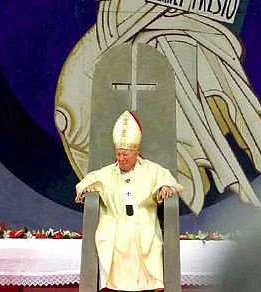Meaning of the Cross of St. Peter
Содержимое
Discover the meaning and symbolism behind the cross of St. Peter, a religious symbol associated with the early Christian martyrdom of St. Peter and his crucifixion upside down. Learn about its historical significance and its representation in art and religious iconography.
The Cross of St. Peter, also known as the Petrine Cross or the upside-down cross, is a symbol that holds a significant meaning in Christian history and symbolism. This particular symbol is associated with the Apostle Peter, one of the twelve disciples of Jesus Christ, and has been used to represent his martyrdom and unwavering faith.
The symbolism of the Cross of St. Peter is derived from a traditional story that Peter was crucified upside down, as he believed he was not worthy to be crucified in the same manner as Jesus. This act of humility and devotion has made the Cross of St. Peter a powerful symbol of Christian faith, sacrifice, and the virtues of humility and selflessness.
In Christian iconography, the Cross of St. Peter is commonly depicted as a Latin cross, with the horizontal bar closer to the top. This inverted positioning distinguishes it from the traditional upright Latin cross and serves as a reminder of Peter’s profound humility and his willingness to give up his life for his beliefs.
The Cross of St. Peter is often associated with the Papacy and the Catholic Church, as St. Peter is regarded as the first pope. It is also seen as a symbol of strength, perseverance, and the triumph of faith over adversity. The inverted cross has been embraced by some as a rebellious symbol, but its true meaning lies in the exemplification of Peter’s unwavering devotion to Christ and his ultimate sacrifice.
What is the Cross of St. Peter?
The Cross of St. Peter, also known as the Petrine Cross, is an inverted Latin cross traditionally associated with Saint Peter, one of the twelve apostles of Jesus. According to Christian tradition, Peter requested to be crucified upside down as he did not feel worthy to be crucified in the same manner as Jesus.
The Cross of St. Peter is often used as a symbol of humility and unworthiness. It serves as a reminder of Peter’s unwavering faith and his willingness to sacrifice his life for his beliefs. The inverted cross is considered a powerful symbol of devotion and a representation of the willingness to follow in the footsteps of Christ, even in the face of adversity.
In addition to its religious significance, the Cross of St. Peter has also been adopted by various groups and organizations as a symbol of their values and beliefs. It is commonly used by the Catholic Church and is seen as a representation of St. Peter’s leadership and authority within the Church.
While the Cross of St. Peter is often associated with the Catholic Church, it is also recognized by other Christian denominations and is seen as a symbol of unity among Christians who honor Peter’s role as the first Pope.
Overall, the Cross of St. Peter holds great significance within Christian tradition and serves as a powerful symbol of faith, humility, and devotion. It is a reminder of the sacrifices made by the early disciples and a call to follow their example in living a life of faith and dedication to God.
History and Origins

The Cross of St. Peter, also known as the inverted cross or St. Peter’s Cross, has a long and rich history dating back to ancient times. According to Christian tradition, St. Peter, one of the twelve apostles of Jesus Christ, was crucified upside down on an inverted cross, as he felt unworthy to die in the same manner as his Lord.
The origins of the symbolism behind the Cross of St. Peter can be traced back to the first century AD. It is believed that when St. Peter was sentenced to death by the Roman Emperor Nero, he requested to be crucified upside down, as a sign of humility and unworthiness. This act of selflessness and devotion to his faith made the inverted cross a symbol of St. Peter’s martyrdom and his dedication to Jesus.
Over time, the Cross of St. Peter became a distinct symbol within Christian iconography, representing not only St. Peter but also the concept of humility and self-sacrifice. It served as a reminder to Christians of the importance of remaining humble and faithful to their beliefs, even in the face of persecution or hardship.
Throughout history, the Cross of St. Peter has been embraced by various Christian denominations and has appeared in religious art, jewelry, and architecture. The symbol has also been associated with the papacy, as St. Peter is considered the first pope of the Catholic Church. Pope Francis, the current Pope, even chose the name Francis in honor of St. Francis of Assisi, who was known for his humility and devotion to the poor.
In contemporary culture, the Cross of St. Peter continues to hold symbolic significance for Christians around the world. It serves as a constant reminder of the importance of humility and the teachings of Jesus Christ. The inverted cross is not a symbol of Satanism or evil, as is sometimes mistakenly believed, but rather a powerful emblem of faith and devotion.
Shape and Symbolism

The Cross of St. Peter, also known as the Petrine Cross or the Inverted Cross, is a distinct religious symbol that takes the shape of an upside-down Latin cross. It features a vertical line intersected by a shorter horizontal line, positioned below the longer line instead of above it. This unique shape holds significant symbolism within the Christian faith.
The inverted position of the cross is often associated with St. Peter, one of the twelve apostles of Jesus Christ. According to tradition, Peter requested to be crucified upside down as he believed he was unworthy to die in the same manner as Jesus. The Cross of St. Peter therefore represents humility and a deep devotion to Christ, as well as a reminder of Peter’s sacrifice and the challenges faced by early Christian believers.
In addition to its connection to St. Peter, the inverted cross has also been adopted by different groups and individuals as a symbol of rebellion or opposition to traditional Christianity. This alternative interpretation of the symbol has caused some controversy and confusion, as it deviates from the original meaning associated with St. Peter. It is important to note that the Cross of St. Peter should be understood within its original religious context rather than any alternative interpretations.
| Upside-down Latin cross | Representation of humility, devotion to Christ, and St. Peter’s sacrifice |
| Inverted cross adopted by alternative groups | Symbol of rebellion or opposition to traditional Christianity |
In conclusion, the shape of the Cross of St. Peter holds profound symbolism within the Christian faith. Its inverted position represents humility and devotion, particularly associated with the martyrdom of St. Peter. While alternative interpretations exist, it is essential to understand the original meaning and historical context of the symbol.
Religious Significance

The Cross of St. Peter holds great religious significance, particularly within the Christian faith. It is often used as a symbol of humility and self-sacrifice, representing the belief in Jesus Christ’s teachings of love, forgiveness, and redemption. The inverted position of the cross is a reminder of St. Peter’s request to be crucified upside down, as he believed he was not worthy to die in the same manner as Jesus. This act of humility and devotion to his faith has made the Cross of St. Peter a powerful symbol for Christians around the world.
In addition to its association with St. Peter, the Cross of St. Peter also represents the concept of transformation and rebirth. The inverted cross can be seen as a metaphorical turning point, symbolizing the turning upside down of one’s life to achieve spiritual growth and enlightenment. It serves as a reminder that through faith and dedication, individuals can overcome their struggles and find salvation.
Furthermore, the Cross of St. Peter serves as a visual representation of the Christian belief in the power of the cross. By embracing the inverted cross, believers express their commitment to following in the footsteps of Jesus and carrying their own crosses in life. It serves as a constant reminder of the sacrifices made by Jesus and the importance of living a life of faith and devotion.
Overall, the Cross of St. Peter holds deep religious significance and serves as a powerful symbol of humility, transformation, and faith within the Christian faith.
Misconceptions and Controversies
Like many symbols, the Cross of St. Peter has been subjected to misconceptions and controversies over the years. One common misconception is that the inverted cross is a symbol of Satanism or evil. This misunderstanding stems from the association of the inverted cross with the Apostle Peter, who was crucified upside down according to tradition. However, the Cross of St. Peter is not a symbol of evil but rather a representation of Peter’s humility and unworthiness to be crucified in the same manner as Jesus.
Another controversial aspect of the Cross of St. Peter is its usage by certain extremist groups. In some cases, the inverted cross has been adopted by hate groups or individuals with anti-Christian ideologies. This misappropriation of the symbol has caused confusion and has led to negative connotations being associated with it.
It is important to recognize that the true meaning of the Cross of St. Peter lies in its Christian symbolism and connection to the Apostle Peter. It should not be misunderstood or misused for nefarious purposes. By understanding the history and significance of this symbol, we can appreciate its true meaning and avoid falling into misconceptions and controversies.
| Related articles: |